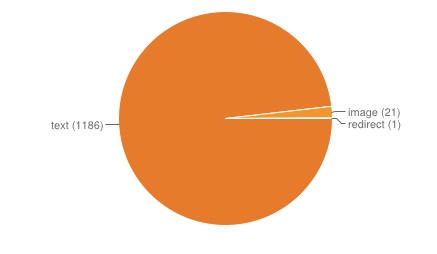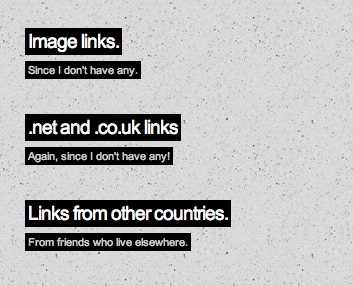Why A Diverse Link Profile Is More Critical Than Ever
I really hate reading articles where people say “I told you so” or blast someone’s techniques, but the recent crackdown and deindexing of blog networks is a great lesson in what can happen if you rely on any one method in link building. I know people who run these types of networks and I know people […]
I really hate reading articles where people say “I told you so” or blast someone’s techniques, but the recent crackdown and deindexing of blog networks is a great lesson in what can happen if you rely on any one method in link building. I know people who run these types of networks and I know people who use them, and I also really, really hate to see anything bad happen, regardless of what I think about the techniques used.
For the record, I don’t see networks as being any worse than a lot of other tactics, so I’m writing this to illustrate a point, not to judge in any way.
We work with some clients who also work with other link builders who do other types of link building than we do. We also work with some clients who dictate what we do, and we work with some who leave it all up to us. Because of this, I think we have a fairly good idea of the full picture and of what works and what doesn’t work.
If I had to choose just one thing that our most successful clients have in common, it would be link diversity.
The sites that continue to enjoy good rankings and traffic are the ones that employ a variety of methods, that either have different groups working on different tactics, or that ask for and follow our advice about how to do things so that they aren’t reliant upon something that can crush them if the algorithm changes.
What Is A Diverse Link Campaign All About?
I think it’s much more than making sure that you have some nofollowed links, some image links here and there, and maybe a few good old sitewides. It’s about analyzing all the opportunities available to you and pursuing anything that you find credible. It’s also about ensuring that you’re visible in the latest and greatest places.
Where To Get Links
For a diverse profile, it’s all about getting your content out there through the use of social media, guest posting, reviews, and many other forms of interaction.
It’s about pursuing blog links, directory links, links on sites where your competitors are listed, and possibly links on crappy sites (trust me, it’s extremely rare to find a link profile that doesn’t include something spammy or questionable) and paid links that will send you lots of traffic.
Anchor Text Variation
I did something very cool recently, at a client’s request. I broke down competitors’ anchor text into categories that he gave me, rather than classifying them in my usual way. It gave me a whole new perspective on anchor text variation.
We tend to think of anchor text in broad categories like money terms or longtails, so breaking anchors down further made me see the smaller picture and identify similarities where I hadn’t seen them before.
Top Level Domain & Geo Variation
I know there are certain gold standards for link building (we love those .govs and .edus!) but I like to see a variety of links from other TLDs like .info, .net, .biz, among others. I also like to see good CCTLDs (country code top level domains) where it makes sense for your audience, but there are few sites that don’t show some sort of foreign links in their profile.
It’s kind of ethnocentric to think that you shouldn’t have those. If you’re doing link outreach and you’re finding targets by searching in Google, run some searches that will only generate results from a specific TLD or CCTLD.
Types Of Links
Permanent, sitewide, footer, sidebar, directories, links that roll off a blog’s homepage, links to your homepage, links to your subpages, profile links, forum and blog comment links, links on sites that show nothing but press releases or articles, links that fade away from a site after a certain amount of time, image links, and yes, even flashing banner links are all part of most profiles that I have analyzed.
I don’t deliberately pursue certain types of links at all times, for various reasons, but in analyzing profiles, it’s apparent that variety is definitely there. Many links that I wouldn’t necessarily pursue (like at the moment I’m not feeling the love for sitewides) are part of a natural profile and can give you great traffic if they’re well placed on the right site.
I’ve had to work on sites that had too high of a reliance upon sitewides, and that’s why I don’t usually seek them out, but I’d take a blogroll link on a great, high-profile blog relevant to my industry over an in-content one on an old site that gets 50 hits a month.
Real World Examples
Our SEO Chicks blog is approaching its 5th anniversary and I’ve used it before as an example of a very natural link profile.
Here’s what we see:
- A really nice percentage of nofollowed links that are giving us good referrals.
- Text and image links.
- A good homepage to deep page link ratio.
- Links from .com, .uk, .org, .net, .us, and .br.
- Link from the Netherlands, Germany, the US, the UK, and Canada.
A quick look at my company website shows the following:
- Links from the US, the UK, Canada, and France.
- Text links and image links.
- Nofollowed and followed links.
- .com, .net, .org, .uk, and .me links.
That is a very simplistic summary of two link profiles that are at least semi-diverse and completely natural (ie., there are no paid links involved.) There is a heavy reliance upon certain types of links (I think we have too few image links and too high a percentage of .com links for my website, for example) but it’s getting to a better place in my eyes.
We also do a local city blog called Avant Greensboro which is very, very new and shows the following:
- Massively high anchor percentage for the brand.
- No image links.
- Links from only .com and .org sites.
- Only links from the US.
Now, as I said we’re just starting out and we have not yet actively pursued links, but I can immediately devise a plan here. Since I like to create wishlists, here you go:
Now, as I’ve said earlier, this is an extremely simplistic (and initial) method of analyzing your link diversity, as it’s limited to what’s been reported by Link Research Tools in my case. However, it’s a start, and it’s a good way to see your profile in terms of its variety in a few areas.
This type of quick analysis won’t tell you things like whether you have enough blog links or whether you’re too reliant upon certain anchors (there are other tools to help you with that) but the key is to think about diversity and to pursue it.
A Final Word
You may have a rare demographic that isn’t engaged socially (yet) for example. However, as we’ve seen with the recent insane growth of Pinterest, new social networks arise that appeal to people who might not have been previously attracted to them. In fact, the people following me on Pinterest are a truly diverse group that includes an old next door neighbor, high school classmates and their moms, and of course all you SEOs.
Who knows what’s next? We may see another Facebook or Twitter, and you will need to promote your site socially. Getting good links on high-traffic blogs with lots of good social signals is (in my opinion) something that will be one of the key ways to build links moving forward. I wouldn’t have said that three years ago.
Think about this too: in the event that something bad does happen with your site in the rankings, being able to keep traffic coming is going to be critical. You have to diversify your traffic sources, period.
Opinions expressed in this article are those of the guest author and not necessarily Search Engine Land. Staff authors are listed here.
Related stories


